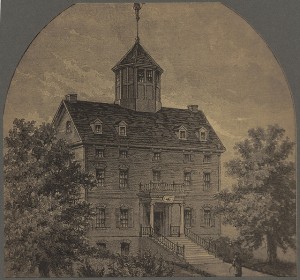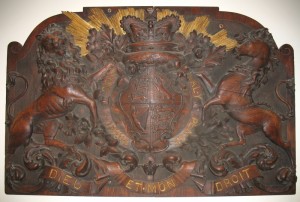By Michelle Marcella (Guest Contributor)
When the Massachusetts General Hospital was chartered by the Massachusetts Legislature in 1811, little thought had been given to just where in Boston the hospital might be housed. To remedy this, the Commonwealth deeded the colonial Province House to the newly minted Mass General for use as it saw fit. Although deemed unusable as a hospital, the trustees leased the Province House. It became the cornerstone of an endowment, one that would require almost seven years of growth before shovel was put to ground in 1818.
Built as a mansion for a wealthy London merchant in the late 17th century, the Province House eventually became the seat of the British government, housing a succession of royal governors. It was filled with artifacts that would become symbols of colonialism, including the royal coat of arms of the reigning monarch. The last of those would be King George III, whose rule would start a revolution.
When the Province House passed into MGH’s hands, a number of these artifacts—including the coat of arms and the building’s copper weathervane in the shape of a Native American archer—came with it. Many of these relics found their way into the collection of MGH surgeon John Collins Warren, who was quite the magpie for items odd and unusual. This was a man who kept a fully assembled skeleton of a mastodon in the front parlor of his Beacon Hill home.
Warren died in 1856, and much of his collection, including his own skeleton, became part of the Warren Museum at Harvard Medical School. Other items, such as the mastodon, would make their way to the American Museum of Natural History in New York City. His papers, some family artifacts and the Province House weathervane went to the Massachusetts Historical Society. Other items came back to the MGH; many assumed this included the coat of arms.
Indeed, for many years a royal coat of arms has been part of the hospital’s special collections. Hand carved from hardwood and vibrantly painted, it is a spectacular piece of art. Until recently, many believed it to have hung in the Province House. Unfortunately, it did not: In fact, it displays the heraldry not of George III but of Queen Victoria, whose reign began some 17 years after George III, and a year before the hospital opened its doors to patients.
A look at the archives provides some details. Correspondence informs us that the coat of arms in the MGH collection came to the hospital in 1939 under the mistaken impression that it was the Province House original. It wasn’t until earlier this year that the hospital discovered—through an inquiry about it status—that its coat of arms was not the Province House original. Rather, the original is on display at the Old State House in Boston, and is part of the original Warren collection that was donated to the Massachusetts Historical Society.
Michelle Marcella is the operations and finance manager at the Paul S. Russell, MD Museum of Medical History and Innovation at Massachusetts General Hospital.


